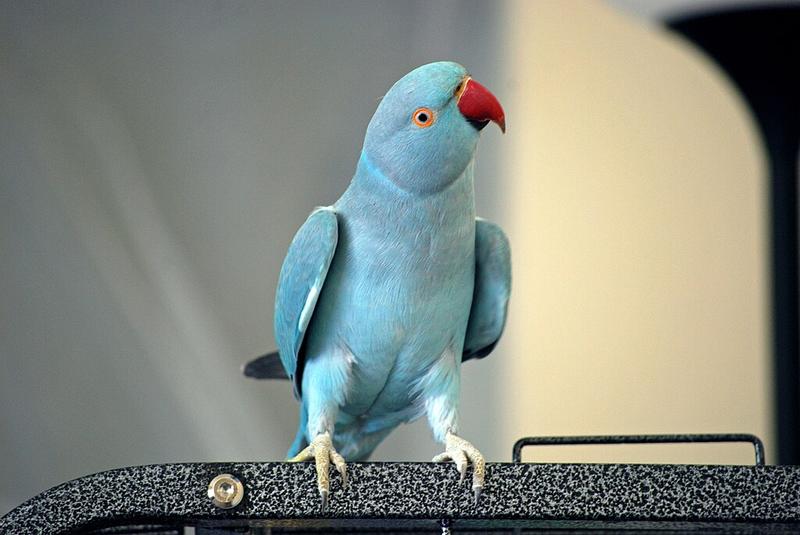Title: Pets in the City: Feathered Friends [MUSIC]
Brian Lehrer: Brian Lehrer on WNYC. On this final day of the fall membership drive, it's our final look at all the different kinds of animals we share our lives with, our pets, in this end-of-the-show series. During the drive, we've talked about dogs and cats, of course, but also rabbits and reptiles and fish and even rats, which surprised me to find that some people keep as pets, but they do. We wrap it up with a slightly different take on a fairly common and, I think, very misunderstood pet, birds.
They present special problems to their owners, and maybe that's not surprising when you remember that birds are considered by some people, living dinosaurs. We'll talk about that quote. We'll hear about that and get some guidance on what it takes to care for these animals from Dr. Lyle Cleary, an associate veterinarian at the Center for Avian and Exotic Medicine in Manhattan. Dr. Cleary, thanks for joining us. Welcome to WNYC.
Dr. Lyle Cleary: Thanks, Brian. Thanks for having me.
Brian Lehrer: Birds are a particular challenge as a pet, right? Should we start with the fact that they can fly over long distances, but as a pet, are confined to a cage or maybe a room?
Dr. Lyle Cleary: The general saying for most parrots is there's no cage big enough. These are animals that basically have intelligence of a six to eight-year-old, also with the energy of a six to eight-year-old. We all know how crazy everyone got during COVID. Imagine that as an everyday life for an animal with incredible intelligence.
Brian Lehrer: That's parrots in particular?
Dr. Lyle Cleary: Yes, that's the ones we see mostly in captivity as a exotic animal practitioner, but there are other birds. Now, most people who keep hawks are actually flying them, so they get a lot more exercise and enrichment, whereas the parrots, they're really lacking stimulation most of the time.
Brian Lehrer: When I was growing up, my best friend had a cute little parakeet. Is that a common pet?
Dr. Lyle Cleary: It is pretty common, at least at my job. I'm lucky enough to work only with exotics, but there's a lot of them around, and a lot of times, on the first warm day of the year, people open their windows, and that bird flies out.
Brian Lehrer: Ouch.
Dr. Lyle Cleary: Yes, those birds usually don't make it very long unless someone gets them into a rescue.
Brian Lehrer: Is clipping their feathers a solution to the flying out risk, or even flying around the apartment if the birds are feeling too caged in?
Dr. Lyle Cleary: I like to trim birds' wings less than once a year. Clipping a bird's wings is like telling your hyperactive kid to sit in a wheelchair. It's really pretty cruel. These are animals that are built for flying nonstop. It really just means keep screen doors in your windows, draw some curtains over the windows if you're worried about them flying into it. It's really considered not fair. They also tend to hurt themselves. These are animals that are built to fly. Their bones are literally hollow and part of their respiratory system. They go to jump and fly, and those hollow bones hit the floor, and we see a lot of fractures from that.
Brian Lehrer: Do smaller birds like parakeets have an easier time as a pet?
Dr. Lyle Cleary: Not necessarily. These are all animals with a lot of intelligence. I know little parakeets that people have trained to step up and speak, and do all sorts of great behaviors and interactions with their owners, which enhances their bonds, but they also get into more trouble. I know some that have gotten stuck in rolls of toilet paper, in the center. Think of that little six-year-old in your house. They're going to touch everything, try to get into it, but then add the third dimension of them being able to fly.
Brian Lehrer: When we say that birds are living dinosaurs, I cited that quote in the intro, where does that come from?
Dr. Lyle Cleary: They're evolutionary closest to dinosaurs, more so than our modern reptiles. They have the hollow bones, they lay eggs. Very close to it. Their respiratory system is very similar to dinosaurs. Now it's common knowing that the dinosaurs did seem bird-like at a certain point. They did have feathers, and that's where flight came from. If you look at the feet of a chicken, you see those scales. That's probably closest to what dinosaurs looked like skin-wise.
Brian Lehrer: Do different birds have distinct personalities?
Dr. Lyle Cleary: Oh, yes. I like to tell everyone most parrots are sexist, racist, and homophobic. I have some bird patients that will attack only men, attack Hispanic men. Some will only attack lesbians. It's amazing. There are some birds that will just be all over me and then--
Brian Lehrer: Really?
Dr. Lyle Cleary: Yes.
Brian Lehrer: What you just said. Really?
Dr. Lyle Cleary: Yes.
Brian Lehrer: Racist, sexist, homophobic birds.
Dr. Lyle Cleary: Yes. They all have their type. There are people who will buy a bird and then what do you know, that bird's more in love with their female partner and then start hating that male person who bought it because that's who they see as their mate. They get imprinted on us, and they start thinking, "Oh, this human is my mate. I'm going to attack everyone else who is not my mate."
Brian Lehrer: You've been talking about and emphasizing the complexities of having a bird as a pet. Have you seen happy pet birds?
Dr. Lyle Cleary: Oh, yes.
Brian Lehrer: Are they affectionate if well cared for, if affectionate is the right word?
Dr. Lyle Cleary: Oh, yes. Just yesterday, I was singing opera with a bird patient who loves only men who are very chill, and on the feminine side. He was singing op with me but lunging at everyone else. I have another patient whose mom is a long-distance truck driver, and Bob, the one-legged cockatoo, drives all over the country with her, and they have a great bond. They live together in the cab of the truck, and they are happy as can be.
Brian Lehrer: Are there rescue birds?
Dr. Lyle Cleary: Oh, yes. One of the problems is with parrots, most parrots are rehomed within two years of purchase because people can't deal with the screaming, the destructiveness, the mess, and just all the care that they need, even if they're healthy, let alone if they're sick. The rescues are actually pretty inundated, and not every rescue can take in birds. There's ones like Foster Parrot, Northeast Avian, Lonely Gray. They really are flooded with birds because, hey, someone who has a Moluccan cockatoo and wants to give it up after two years, that's a bird that's going to potentially live another 80.
Brian Lehrer: There's an estate planning issue, too, I imagine, for some people?
Dr. Lyle Cleary: Entirely. It's an impulse buy for a lot of people, "Oh, they're pretty," but then the reality of living with an animal that, at dawn, is going to be screaming. I don't know who's decided these loud animals belong in the house, but I'm sure they're laughing in their grave.
Brian Lehrer: 20 seconds. There's a bill at city council right now, New York City Council, to make it illegal for pet stores to sell birds. Do you think they should go that far?
Dr. Lyle Cleary: I think so. I think they should not be selling it. Their rescues are too, too full.
Brian Lehrer: We leave it there with Dr. Lyle Cleary, a veterinarian at the Center for Avian and Exotic Medicine on Columbus Avenue in Manhattan. Thank you very much for joining us, even though your message about keeping pet birds was very bracing. Thank you.
Dr. Lyle Cleary: No problem. Take care, Brian.
Copyright © 2025 New York Public Radio. All rights reserved. Visit our website terms of use at www.wnyc.org for further information.
New York Public Radio transcripts are created on a rush deadline, often by contractors. This text may not be in its final form and may be updated or revised in the future. Accuracy and availability may vary. The authoritative record of New York Public Radio’s programming is the audio record.


